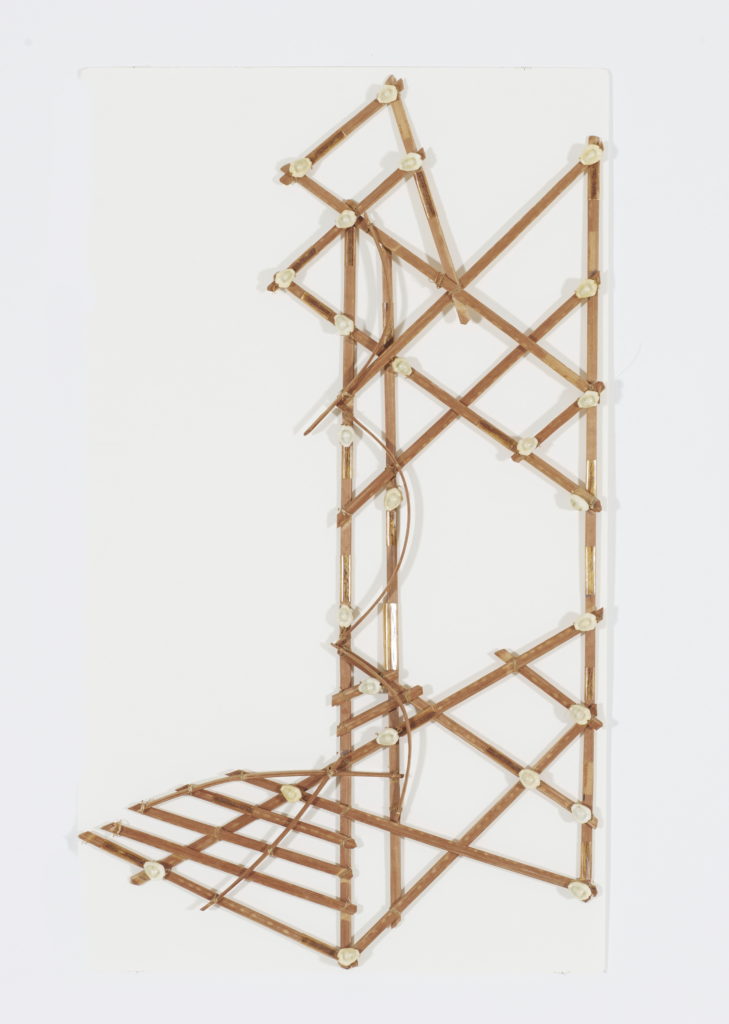
Meto (stick chart)
liok / mālwe (aerial pandanus root (or coconut frond midrib))
libbukwe / likajjid (cowrie shells)
kokwal̗ (coconut sennit (rope))
ED# 8864
Accessioned May 1986. Gift of Betty Shigemitsu.
Meto in ej juon iaan men ko bwinjen juon ri-jerakrōk ej kōjerbale n̄an katakin juon eo ej ekkatak meto. Ej kōm̗m̗an jān liok ak mālwe. Libbukwe ko rej kobaik tok n̗a ippān meto in. Libbukwe rōkāāl im rej kab kōkōn raan kein jān ippān ri-amim̗ōn̗o ro. Aolep men kein rej āji ippān doon kōn kokwal̗ eo. Meto in kar l̗ōmake bwe ri-katak eo ej katak meto en kōkeememeji ae im n̗o ko ikōtaan aelōn̄ ko ilo Rālik unin an jimattan in. Ae im no kein rej alikkar ilo jekjekin an jim̗we im kob liok ak mālwe kein me libbukwe kein rej pad ie. Meto in ej jerbal wōt ioon āne kōnke aolepān jel̗ā eo epād ioon wa eo ilo̗jet. Ekkar n̄an bwebwenato ko, meto ekar ijjino jān ippān juon em̗m̗aan ekar pel̗o̗k im eotōk l̗o̗k Namdik. Litarmelu, jān Namdik, ekar karuwaineneiki n̄an m̗weo m̗ōn kōnke ejjel̗o̗k ekar kōn̗aan lale l̗eo ālikin an mālim an maron̄ pād im mour ioon Namdik. Ālikin elōn̄ tōre tok ālik, Litarmelu im l̗ein ekar wōr jet nejierro l̗addik. Juon iaer ej L̗ainjin. Litarmelu ekar bōk L̗ainjin im katakini meto ilo an kōjerbal meto, mattan̄, rebbelib, kab wapape eo ioon āne. Ālikin an L̗ainjin ekkatak, ej wanmeto l̗o̗k ippān jinen n̄an ioon wa eo bwe en ilen ekkatak meto ippān Litarmelu. L̗ainjin ekar bōk dekā-in-nin eo an jinen im jol̗o̗k likiej in Namdik. Ke ej jol̗o̗k dekā-in-nin eo, ej jiron̄ l̗o̗k l̗ōm̗aro rej kōn̗aan ekkatak meto ippān, “Tuur likiej in Namdik.” Mel̗el̗e in bwe n̄e l̗ōm̗aro ro rōnaaj tulo̗k im tuur lōn̄ tak dekā-in-nin eo an jinen, innām enaaj katakin er meto. Rainin, an jejjojo wōt bwij kapeel in. Ijoke, elukkuun m̗ōj an jako l̗o̗k kapeel in kōnke ri-meto ro em̗ōj aer jako. Ri-meto eo ālik tata ej Captain Korent Joel.
The meto is one of the teaching devices. It is made from aerial roots of pandanus or from the coconut frond midrib. Cowrie shells are added to the frame. The cowrie shells are a contemporary addition by the craftsmen. All these are assembled together with a coconut rope. The meto was created to sharpen the memory of an apprentice navigator so he remembers the currents and swells in between and around the islands in the Rālik (sunset = west) Chain, which is why it is half the size of the rebbelib. These currents and swells are represented by the pandanus roots and or coconut midrib sticks. It is used only on land because the practical knowledge is attained on the canoe in the water.
According to legends, navigation (meto) originated from a stranger who washed ashore on Namdrik Atoll. Litarmelu, from Namdrik, welcomed him and provided him hospitality because the Namdrik community did not want him. After a few years, Litarmelu and the man had a few sons. One of them was Lainjin. Litarmelu taught Lainjin navigation (meto) by using the meto, mattan, rebbelib, and wapepe stick charts on land. After Lainjin’s stick chart lessons, he went on the canoe with his mother, Litarmelu. Lainjin took his mother’s pandanus pounder and threw it in the deep ocean on the windward side of Namdrik Atoll. As he threw it, he told the apprentices that if they want to learn navigation, “Go dive down [for the pounder] at the windward side of Namdrik.” He meant that if the apprentices retrieved his mother’s pandanus pounder, he would reward them by teaching them navigation. Today, only a few clans have members who possess this proprietary knowledge. However, the skill has died with a lot of the skilled navigators who have passed away. The last navigator was Captain Korent Joel.

Add a Comment